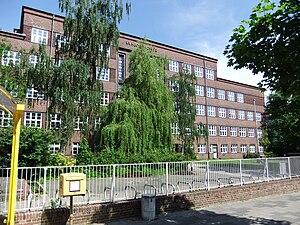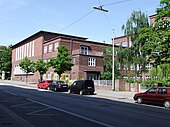Humboldt School Bremerhaven
| Humboldt School Bremerhaven | |
|---|---|

|
|
| type of school | High school |
| founding | 1927 |
| address |
Schillerstrasse 87, 27570 |
| place | Bremerhaven - Geestemünde |
| country | Bremen |
| Country | Germany |
| Coordinates | 53 ° 31 '39 " N , 8 ° 35' 50" E |
| Website | www.humboldtschule-bremerhaven.de |
The Humboldt School Bremerhaven in Bremerhaven - Geestemünde is a secondary school . Its building, inaugurated in 1930, has been a listed building since 2004 .
history
Foundation and new building
Geestemünde grew rapidly in the 1910s and 1920s. The pupils had to be taught in so-called “flying classes” or “hiking classes” because of the school space shortage. The city of Wesermünde , created in 1924 from the cities of Lehe and Geestemünde , has therefore been planning the establishment of an additional elementary school for Geestemünde and the construction of a new school building with 16 classrooms, additional specialist rooms, a school kitchen and a gymnasium since 1924.
The first rector of the new school was the middle school teacher Theodor Graue, who as rector of the Neumarktschule with five classes was assigned another five classes from the Allmersschule and three from the Altgeestermünder girls’s school for the new school. The school was given the name of the Humboldt brothers ( Wilhelm von Humboldt and Alexander von Humboldt ) at this early stage .
The property selected for the new school building was at the end of Schillerstrasse , on the corner with Grünenstrasse (today Georg-Seebeck-Strasse). The architect of the building planned from 1928 and completed on April 28, 1930 was the Wesermünder Stadtbaurat Wilhelm Kunz (1880–1945). The three- to five-story, with Bockhorner and Oldenburg clinker -clad building is a typical representative of the new architecture of the 1920s, also influenced by the North German Brick Expressionism . The construction costs amounted to 1.1 million Reichsmarks . The building should be a model for a progressive elementary school. It was a "spectacularly complex municipal building project in economically desolate times"
In 1930 574 pupils could be taught. At the elementary school there were also upper classes (G-, later M-branch), with the aim of the secondary school entrance qualification; the same took place at the grain school in Lehe. In 1932, four G-classes with around 50 students per class had to be admitted to the Humboldt School in Wesermünde - elementary school with an extension train ; four primary school classes came to other schools in Geestemünde.
time of the nationalsocialism
At the time of National Socialism teaching according to the dominant ideology was organized: Nazi textbooks, flag ceremony , dominance by HJ Youth and League of German Girls (BDM), air drills, air force auxiliary , HJ Navy helpers , fire guards, canceled classes, Kinderlandverschickung were the keywords in this Time. As early as the late 1930s, boys and girls were allowed to be taught together ( coeducation ); they were only separated from the class by the aisle. In 1941 the north wing, the gymnasium and the teachers' room were occupied by soldiers and internees. In 1944 the north wing burned down. Rector Graue died in Kührstedt three hours before the armistice on May 4, 1945 during World War II . He was followed by the rector of the destroyed Alt-Geestemünder girls' school in Rabens.
State of emergency after 1945
The Humboldt School was able to resume teaching on September 19, 1945 with 32 classes. Too few teachers, classrooms, school materials and furniture as well as coal holidays (1946/1947), rubble clearance campaigns, hiking classes or lessons in barracks shaped the lessons. School meals alleviated the nutritional deficiency. The then 36 classes with 1679 students were taught in 19 rooms by only eleven teachers working in shifts. Each class had around 50 students.
From March 1946, students from the destroyed Allmersschule (until a new building was completed in 1951), the auxiliary school Humboldtschule II, the construction train and the Catholic school (Humboldtschule I) were also housed in the building. At the beginning of the 1950s, a gymnasium, the auditorium and rooms in the attic were again available. In 1959 an extension was added. The situation did not normalize until the 1960s and 1970s. The student protests of 1969 marked the educational emergency at this school. In 1963 a new sports facility was inaugurated. The second gymnasium had been in operation since 1970. The first part of a school garden was laid out in 1984/1985. Another extension with two work rooms, a multi-purpose room and ancillary rooms was built in the 1990s.
Lots of reforms
High school
In 1950, as part of a reform in Bremerhaven, six schools - including the Humboldt School - became an upper school (called Volksoberschule ) with branches A or later H ( secondary school ), B or M ( middle school ) and D or G ( grammar school ). The high school branch was oriented towards mathematics and science. French was the second foreign language after English. The transition after the six-year elementary school was coordinated with the Geestemünder elementary school, the Allmersschule .
From 1957, the six-year elementary school for all children was abolished and “students with clearly recognizable theoretical talent” were allowed to switch to the fifth and sixth grades of the grammar school after a selection process after the fourth grade.
In 1977/1978 the four-year elementary school and the orientation level were uniformly introduced in the Free Hanseatic City of Bremen .
School center of the lower secondary level
As part of the upper level reform of 1975, the Humboldt School lost its upper level. It was now a secondary school center . Grades 11 to 13 of the six grammar schools in Bremerhaven were concentrated at three other school centers.
Humboldt School currently
Today the Humboldt School is a school center for the lower secondary level, since 2010/2011 called Oberschule . It prepares its students for entry into vocational training or the continuation of training in the gymnasiale Oberstufe or another school of the upper secondary level .
By 2010/2011 some of the pupils in the 5th grade started attending secondary school . At the end of the 8th grade, some of the students could decide whether they wanted to obtain the vocational qualification or the secondary school leaving certificate. The other part of the pupils attended the grammar school up to the 9th grade and then switched to one of the upper school centers of the city.
From 2011/2012 all pupils at the Humboldt School will start attending secondary school. The first two years are for orientation. The lessons are only partially geared towards heterogeneous learning groups . From the 7th grade onwards, classes or learning groups are partly with homogeneous performance.
It takes place "the subject teaching in class, the common learning in integrated teaching areas and the learning in other places and beyond the school subjects" instead. Project lessons and practical days are the norm in secondary school.
The youth music school of the city of Bremerhaven offers instrumental lessons in the music-oriented school.
The Humboldt School Friends' Association supports the school.
Well-known teachers and students
Alphabetical order
Headmaster and teacher
- Peter Becker, headmaster in the 1990s and 2000s (until 2012)
- Manuel Casielles Prida, Didactic Director of the Humboldt School since 2018 until today
- Herbert Brust (1900–1968), music teacher in the 1950s, he composed a school anthem
- Theodor Graue, rector from 1927 to 1945
- Emma Hartmann, headmistress until 1953
- Brigitte Lückert , senior director of studies, headmistress since the early 1980s
- Ralf-Dieter Loell, director of the Humboldt School since 2017 until today
- Werner Otto, senior director of studies, headmaster from 1979 to the early 1980s
- Berthold Riethmüller (1922–198?), Senior director of studies, conservative headmaster from 1969 to 1979
- Karl Rohloff, senior director of studies, headmaster from 1957 to 1969
- Thomas Tjarks, principal since the 2000s to 2017
- Johannes Trautmann, senior director of studies, headmaster from 1953 to 1957
- Walter Zimmermann (1892–1968), Bremerhaven city school council , 1954 to 1961 teacher on fee
student
- Klaus Hurrelmann (* 1944), social, educational and health scientist, university lecturer
literature
- Harry Gabcke , Renate Gabcke, Herbert Körtge, Manfred Ernst: Bremerhaven in two centuries. (Volumes I to III from 1827 to 1991.) Nordwestdeutsche Verlagsgesellschaft, Bremerhaven 1989/1991, ISBN 3-927857-00-9 / ISBN 3-927857-37-8 / ISBN 3-927857-22-X .
- Manfred Kandsorra: Humboldt School. Bremerhaven 2001.
Web links
Individual evidence
- ↑ Monument database of the LfD Bremen
- ↑ Nordsee-Zeitung of October 14, 2004.
- ↑ see the school portal of the Humboldt School


